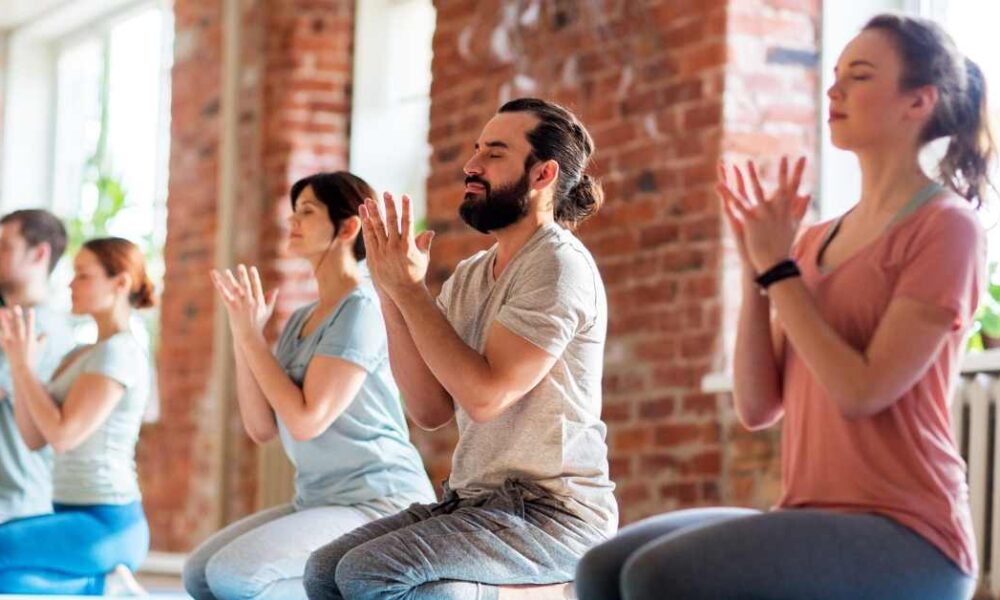Key Takeaways:
- Yoga offers physical, mental, and spiritual benefits.
- Physical benefits include improved strength, flexibility, posture, and cardiovascular health.
- Yoga promotes mental and emotional well-being by reducing stress, anxiety, and depression.
- Yoga philosophy and meditation techniques help cultivate a sense of inner peace and spirituality.
- Yoga can be practiced anywhere, including at home, while traveling, or through virtual classes.
- Deepening your yoga practice involves exploring philosophy, attending workshops, and practicing advanced techniques.
- Finding inner balance and peace is a key goal of yoga.
- Yoga can be tailored to meet the needs of beginners, pregnant women, seniors, and individuals with limited mobility.
Yoga has been practiced for centuries and is known for its transformative power, offering numerous benefits to the body, mind, and spirit. The practice of yoga encompasses a wide range of dimensions, each contributing to our overall well-being. From physical strength and flexibility to mental clarity and emotional balance, yoga offers a holistic approach to self-care and self-discovery.
The Many Dimensions of Yoga
Yoga goes beyond physical exercise; it is a multidimensional practice that encompasses various aspects of our being. Here are the three main dimensions of yoga:
1. Physical Benefits of Yoga
One of the most apparent benefits of practicing yoga is the improvement of physical health. Yoga postures, known as asanas, help strengthen and stretch the body, promoting flexibility, balance, and muscle tone. Regular yoga practice can also enhance posture, relieve chronic pain, increase energy levels, and boost the immune system.
Moreover, yoga improves cardiovascular health by reducing blood pressure, decreasing cholesterol levels, and promoting efficient circulation. It can also aid in weight management and contribute to a healthy metabolism.
2. Mental and Emotional Well-being
Yoga is not just about the physical aspect; it also offers a wealth of mental and emotional benefits. The practice of asanas and pranayama (breathing exercises) can calm the mind, reduce stress, anxiety, and depression, and improve concentration and focus.
Regular yoga practice stimulates the release of endorphins, also known as the “feel-good” hormones, which contribute to overall well-being and happiness. Yoga incorporates mindfulness and meditation techniques that help cultivate a sense of inner peace and promote emotional balance.
3. Spiritual Connection through Yoga
Yoga has deep roots in spirituality and offers a pathway to connect with our inner selves and the universe. Through the practice of yoga, we can tap into our spiritual essence and find a sense of purpose and fulfillment.
Meditation and chanting, often incorporated into yoga practice, allow us to quiet the mind, go beyond the surface level of existence, and gain a deeper understanding of ourselves and our connection to the world around us. Yoga philosophy teaches us principles such as non-violence, truthfulness, and contentment, which can guide our actions and bring about a greater sense of spirituality and harmony.
Yoga Anytime, Anywhere
One of the beauties of practicing yoga is its versatility and accessibility. Whether you prefer to practice at home while traveling, or through online platforms, yoga can be incorporated into any lifestyle. Here are three ways to practice yoga anytime, anywhere:
1. Home Yoga Practices
Practicing yoga at home allows you to create a personalized and comfortable environment for your practice. You can set aside a designated space, such as a spare room or a corner of your living room, where you can roll out your yoga mat and engage in a session tailored to your needs.
There are numerous resources available, such as online videos, yoga apps, and books, that provide guided yoga routines for all levels. Developing a home yoga practice allows you to have flexibility in scheduling your sessions and explore different styles of yoga at your own pace.
2. Yoga on the Go: Travel-friendly Routines
Traveling should not hinder your yoga practice; instead, it can be an opportunity to explore new environments and incorporate yoga into your journey. Whether you are staying in a hotel room or camping in the wilderness, there are simple and effective yoga routines that can be practiced even in a small space.
Travel-friendly yoga sequences often focus on stretching, gentle movements, and relaxation to counteract the physical and mental stresses of travel. These routines can help alleviate jet lag, improve circulation during long flights or car rides, and provide a sense of grounding and balance during your travels.
3. Virtual Yoga Classes and Online Communities
In the digital age, yoga has become accessible to anyone with an internet connection. Virtual yoga classes and online communities offer the convenience of practicing yoga from anywhere in the comfort of your own home while connecting with a global yoga community.
Many experienced yoga teachers and studios now offer live-streamed classes or recorded sessions that can be accessed at any time. Virtual yoga classes provide the opportunity to learn from renowned teachers around the world, explore different styles of yoga, and interact with fellow practitioners through online platforms.
Unlocking the Power Within
As your yoga journey progresses, you may find yourself yearning for a deeper connection with your practice. Here are three ways to unlock the power within and take your yoga practice to the next level:
1. Deepening Your Yoga Practice
Deepening your yoga practice involves exploring the various aspects of yoga beyond asanas. This includes delving into the philosophy of yoga, studying ancient texts like the Yoga Sutras of Patanjali, and understanding the principles that guide yogic living.
Additionally, deepening your practice may involve attending workshops or retreats led by experienced teachers who can provide guidance on advanced techniques, meditation practices, and the integration of yoga into everyday life.
2. Advanced Yoga Techniques and Poses
Once you have established a strong foundation in your yoga practice, you can begin exploring advanced techniques and poses. These may include inversions, arm balances, and deeper backbends. However, it is essential to approach advanced poses with caution and under the guidance of a qualified yoga teacher to prevent injuries.
Advanced yoga practice not only challenges the body but also cultivates mental clarity, focus, and perseverance. It can lead to a greater sense of self-awareness and a profound connection with your physical and energetic body.
3. Finding Your Inner Balance and Peace
Ultimately, yoga is a journey of self-discovery and the pursuit of inner balance and peace. Beyond the physical and external aspects of yoga, the aim is to cultivate a state of equanimity within ourselves.
This can be achieved through consistent practice of meditation, breathwork, and mindfulness. By staying present and cultivating self-compassion, we can navigate the challenges of life with grace and find solace in the stillness within.
Yoga for Everyone
Yoga is a practice that can be adapted to suit individuals of all ages, abilities, and life stages. Here are three specific areas where yoga can be tailored to meet the needs of specific populations:
1. Yoga for Beginners: Getting Started
Starting a yoga practice can be daunting for beginners, but the benefits are well worth the effort. Yoga for beginners focuses on introducing basic postures, alignment principles, and breath awareness.
Beginners’ classes often emphasize proper alignment to prevent injuries and build a solid foundation for future practice. These classes may also incorporate modifications and props to cater to individual needs and limitations.
2. Prenatal and Postnatal Yoga
Prenatal and postnatal yoga are specifically designed to support women during pregnancy and after childbirth. These specialized practices help strengthen the body, alleviate discomfort, and prepare women for labor and motherhood.
Prenatal yoga focuses on gentle movements, breathing techniques, and relaxation to promote physical and emotional well-being during pregnancy. Postnatal yoga focuses on rebuilding core strength, promoting healing, and establishing a connection with the newborn.
3. Yoga for Seniors and Individuals with Limited Mobility
Yoga is a valuable practice for seniors and individuals with limited mobility, as it helps improve balance, flexibility, and joint health. Modified poses and gentle movements are incorporated to accommodate physical limitations and ensure a safe and comfortable practice.
Yoga for seniors and individuals with limited mobility promotes independence, reduces the risk of falls, and enhances overall well-being. It provides an opportunity for connection, self-care, and maintaining a vibrant quality of life.
In conclusion, yoga is a transformative practice that offers a multitude of benefits for the body, mind, and spirit. Whether you are a beginner exploring the basics or a seasoned practitioner seeking to deepen your understanding, yoga has something to offer everyone. By practicing yoga anytime, anywhere, and in various ways, you can unlock the power within and embark on a serene journey of self-discovery. So, roll out your mat, take a deep breath, and let the transformative power of yoga unfold.





